A new concept of digital transformation (DX) wherein information and communication technology (ICT) is improved in all facets of life has been penetrating society at an exponential rate. Industries have been witnessing a great shift in consumer demand from the era of high quality and user-friendly products to a new era of valuable new services which are generated from collected data utilizing ICT, resulting in more and more companies across different industries venturing into new business territories and creating new businesses in collaboration with companies from different industries. Looking at this change from an intellectual property view point, there has been a growing number of patent application filings related to so-called business methods (business-related inventions) which are patents granted for new business models or services. Amazon's One-Click patent is one example of well-known business method patents. (Japanese Patent Numbers 4937434/4959817 registered in 2012) The claimed functions in the patents enable on-line customers to make a purchase order of a product by clicking a button on screen only once without needing to confirm the order. As such, ubiquitous services that customers enjoy today are mostly linked to business method patents. This article will introduce and analyze the current trend in business method patents with relevant statistics on "Recent Trends in Business-related Inventions" published by the Japan Patent Office (JPO) in July 2020. The article will also propose how companies should file a business-related invention when they make a foray in to a new business territory.
What is a business method patent?
A patent is granted for not merely an invention unique to a product but also an idea or a service, such as a business model. A business method patent is granted for an invention in which the method is realized by utilizing ICT. Its technical field falls under International Patent Classification (IPC) G06Q* defined by the World Intellectual Property Organization (WIPO).
Similar to other countries, one critical point when granting a patent is determining whether a business method is deemed to be an "invention" or not. The Japanese Patent Law stipulates that an "invention" means "the highly advanced creation of technical ideas utilizing the laws of nature" (Japanese Patent Law, Article 2(1)). This means that any laws and rules unrelated to law of nature, such as economic laws, any rules determined by human beings, and mathematic formula are not eligible for patent subject matter.
[Note]
IPC Definition of G06Q *
data processing systems or methods, specially adapted for administrative, commercial, financial, managerial, supervisory or forecasting purposes; systems or methods specially adapted for administrative, commercial, financial, managerial, supervisory or forecasting purposes, not otherwise provided for.
For example, in case of an IoT business model consisting of the following processing (1) to (6) steps, step (5) data utilization and (6) establishment of the new business model are regarded as methods embodying the company's business model and hence, can be protected as a business method patent.
[IoT business model (excerpted from the JPO report)]
(1) collecting data from various sensors or devices, (2) transferring the collected data, (3) storing the transferred data in the storage system as "Big Data", (4) analyzing the stored data by using AI etc. and outputting new data, (5) utilizing the output data to any service, (6) establishing business model in IoT.
Filing trends in business method patents in Japan
The concept of patentability of a business method patent appears to have begun from one noteworthy US court case decision, State Street Bank & Trust Co. (State Street) vs, Signature Financial Group, (Signature), back in 1998: the United States Court of Appeals for the Federal Circuit (CAFC) found validity of the business method patent assigned by Signature regarding "Hub and Spokes," an administrative system for investment funds. Following the decision, business method patents were granted at the U.S. Patent and Trademark Office (USPTO) such as "Reverse-Auction" patent by Priceline, a US online auction house, in 1998, and the "One-Click" patent by Amazon.com in 1999.
That new wave of business method patents in the U.S. had triggered a drastic increase on filing the patent applications in Japan in 2000 (Graph 1). Having said that, most of the applications were just simple business models not composing any technical ideas. In October 2000, the JPO announced that business methods were examined based on software-related invention, indicating their clear direction on to what extent is patentable as a business method patent. Subsequently, the JPO revised the Examination Guidelines in a bid to clarify its definition of business method patents in December of the same year. This JPO examination change brought a downward trend of filing business-related inventions after 2000. Later, that filing trend turned upward since 2012, marking 9,921 cases in 2018. This upward tendency has been spurred as robust solution-based business, popularization on smartphones and SNS, cutting-edge AI and IoT technologies created new services leveraging ICT. In particular, the increase is remarkable in the fields of consumer-based online business, automation and optimization on internal operational system, fintech and healthcare.
As shown in Graph 2, the patent grant rate bottomed in 2000 when most filing cases were related to mere business models amid the filing boom. However, as mentioned the above, the JPO's precise instruction on the patent subject matter of business-related inventions led to improving the low patent grant rate as the number of patent applications related to such mere business models was decreasing.
More focusing on trends in 2009 and later, the Intellectual Property High Court (IPHC) rendered decisions on whether a person skilled in the art could easily arrive at a claimed invention (inventive step). The IPHC indicated their view that citations were not accepted as primary grounds for judging inventive step as long as problems to be solved and motivation, which are related to other prior inventions or well-known technologies, did not exist in the citation. Those IPHC judgments set a high bar when rejecting applications based on inventive step. Those IPHC judgements had the JPO reconsider the criteria for determining inventive step and the grant rate was gradually increased. In recent years, the patent grant rate for business method patents have stayed at a relatively high level similar to that of other technical fields.
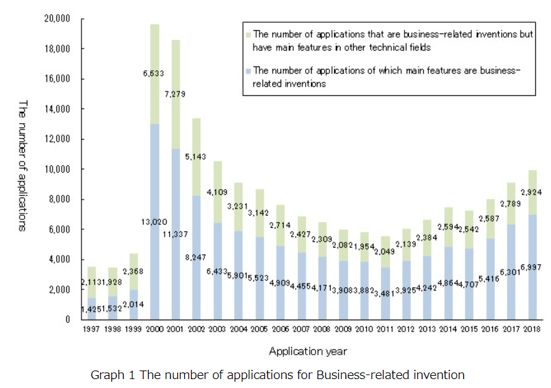
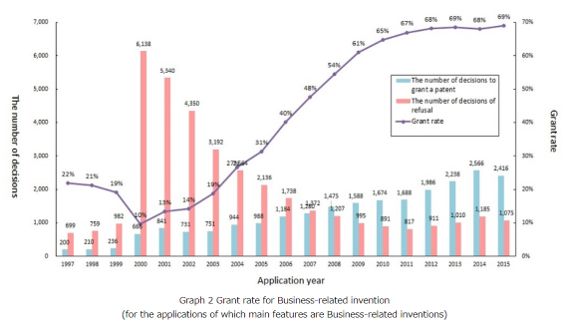
[Note]
Graph 1 and 2 are excerpted from the JPO report on "Recent Trends in Business-related Inventions" which was updated in July 2020 (https://www.jpo.go.jp/e/system/patent/gaiyo/recent_trends_biz_inv.html). The following remarks relate to the collecting the above data.
- "Applications of which main features are business-related inventions" refers to an application classified into G06Q as main FI.
- "Applications that are business-related inventions but have main features in other technical fields" refers to an application classified into G06Q as FI and also classified into other FIs as main FI.
- The number of applications is the total number of (1) the number of domestic applications and (2) the number of international applications based on Patent Cooperation Treatment (PCT) and transferred into the national phase in Japan. The number includes undisclosed applications for which a decision of refusal, (deemed) withdrawal, or abandonment was made prior to publish.
- The application date of PCT international applications is determined as the acceptance date of the domestic document.
- Grant rate = number of decisions to grant a patent / (number of decisions to grant a patent + number of decisions of refusal + number of withdrawals or abandonment after FA)
Practical tips when filing business-related inventions
Just as the above explains that business method patents are patents granted for new ideas or services, but they had long been considered to be difficult to enforce. Because competitors can easily avoid possible infringement by making amendments to create subtle differences from the patented invention, patentees struggle to establish proof of infringement. Therefore, it is important for applicants to foresee their future business development and utilize business method patents from the patent prosecution stage.
Tip 1) Satisfying patentability requirements for business method patents
When filing business-related inventions, an applicant should take consideration on patent eligibility and inventive step, in particular, which are often not admitted by the JPO.
In response to a growing number of filing cases related to business method patents, which are examined as software-related inventions across various industries, the JPO further revised the Examination Guidelines in 2018 and suggested some exemplary cases of patent eligibility. In addition, the JPO also suggested points to be considered on inventive step on business method patents. The below chart and explanation show patent eligibility and inventive step on business method patents.
- Whether the claimed invention is recognized as invention? (patent eligibility)
In accordance with the following chart, the JPO Examiners look into and determine whether the claimed invention falls under "creation of a technical idea utilizing a law of nature" and information processing by the software is concretely realized by using hardware resources in the claimed invention.
Chart: Process of determining eligibility for patent for a software-related invention
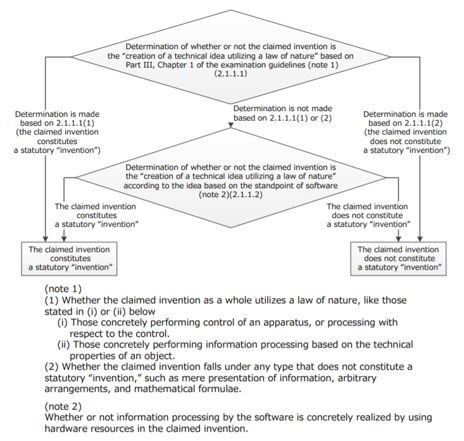
[Note]
The JPO Examination Handbook Annex B Chapter 1 Computer Software-Related Inventions 2.1.1.
In a nutshell, if information processing based on certain purposes by software and hardware co-working is obviously realized, the business method is deemed as an invention.
2)inventive step
If business operation and models conducted by humans are able to be systemized and implemented to computers in some degree of daily routines, it is regarded as presenting ordinary creativity and hence, inventive step of the certain invention is rejected by the JPO. In contrast, if technical advantage which has been achieved with setting certain technical conditions remarkably exceeds a scope projected by technical standards at filing the patent application, inventive step is presumed to be existent.
Noteworthy business method patents in Japan
Applicant: Pepper Food Service Co., Ltd.
Title of Invention: A steak delivery system
Japanese Patent Number: 5946491
Scope of claims (underlined phrases are corrected part of the claim during an opposition was examined at the JPO):
Claim 1
A steak delivery system to conduct a steak delivery method including a step of directing a customer to a standup-style dining table, a step of asking the customer for a desired amount of steak, a step of cutting the desired amount of steak from a chunk of meat, a step of cooking the meat, and a step of bringing the cooked meat to the customer's table, wherein the steak delivery system has
a tag with the table number of the aforementioned customer,
a weighing machine to weigh the meat which was cut at the aforementioned customer's request, and
a mark to distinguish the meat which was cut at the aforementioned customer's request from other customers' meat,
characterized by printing out a sticker showing the amount of meat which was weighed by the aforementioned weighing machine and the table number of the customer, and
the aforementioned mark is a sticker showing the amount of meat which was weighed by the aforementioned weighing machine and the table number of the customer.
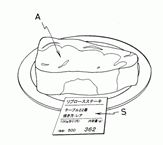
JPO Judgment (Non-patentable subject matter):
The JPO had concluded that "a tag," "a weighing machine," and "a mark" are just specific components which suggest one use of genuine functions and limit the use to no more than tools. The JPO decided that the business model in question does not correspond to an invention. (violation of the Japanese Patent Law Article 2(1))
IPHC Judgment (patentable subject matter):
The IPHC concluded that "a tag," "a weighing machine," and "a mark" are provided as technical means to solve the problem of the patented invention by preventing a situation wherein one customer's meat is confused with that of another customer". It can be said that the patented invention corresponds, as a whole, to "the creation of a technical idea which utilizes a law of nature". Therefore, the patented invention corresponds to an invention as stipulated under Japanese Patent Law Article 2(1).
Comparison with other jurisdictions (U.S., Europe, and China)
Although the following figure (Graph 5) showing the patent grant rate of business method patents does not indicate, business method patents are more likely to be granted in Japan than the U.S. and Europe. As mentioned earlier, such an uptick trend has been attributed to robust business solution services, pervasiveness of smartphones and SNS, and technical advancement on AI and IoT. It is also assumed that patent grant rate at certain level may motivate applicants to file more applications in the field.
In the U.S., after the Supreme Court decision on Alice Corp. v. CLS Bank in 2014, the patent eligibility for business-related inventions is highly likely to be rejected. That said, certain number of business method patents are filed because the US is a key market for many corporations.
In Europe, criteria on inventive step is stricter although the EPO criteria is similar to the JPO. Such stringent criteria seems to reflect on fewer business-related invention cases filed at the EPO.
[EPO criteria on inventive step]
- Whether an invention has technical features, such as technical components, technical contribution
- Whether a business method, which is realization by IT, brings technical effects which exceeds ordinary computer operating capability
In China, business method patents are unlikely to be granted. Curiously enough, despite that trend, the number of the cases filed by Chinese applicants which is shown in Graph 5, is overwhelming compared with applicants in the other countries. Chinese companies are amid of active engagement on overseas business development, and it may result in the growing number of the cases.
Assumingly, difference in judicial criteria and business situation reflects the recent trend on the number of business method applications.
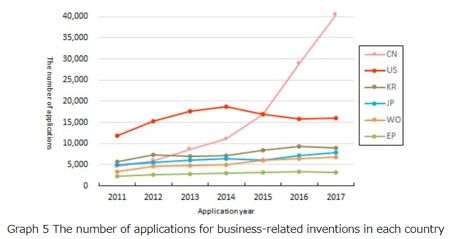
[Note]
Graph 5 is excerpted from the JPO report on "Recent Trends in Business-related Inventions" which was updated in July 2020 (https://www.jpo.go.jp/e/system/patent/gaiyo/recent_trends_biz_inv.html).
Outlook
The 2020 JPO Annual Report shows top tier patentees registered business method patents in 2019 (Fig.1). The top tier patentees are among various technical fields, ranging from a giant e-commerce retailer, Z Holdings (a.k.a. YAHOO), Japanese IT maker, Fujitsu, to human resources business, Recruit, flea market app provider, Mercari, and office equipment manufacturer, Ricoh. It can be said that business methods are so diversified in technology that various companies can easily join in regardless of their business type or industry.
Even if a new idea is something subtle but still offers a business solution, obtaining business method patents and strengthening their IP protection in their own business territory is getting more and more important. On top of that, in order to survive competitive markets for years to come, it is essential for patent holders to actively lay out their business strategy leveraging their owned patents and not allowing them to become dormant.
In response to diversity in business models, the JPO has revised the Examination Guidelines and the Examination Handbook by attempting to make them more easily understandable by applicants. The next challenge is how the JPO will handle future infringement cases related to business methods patents. Therefore, the JPO needs to further discuss the matter in depth. For example, in the case of platform businesses generating profit which is not directly linked to patented inventions, there has been some ambiguous recognition of the amount of compensation for damages caused by infringement acts. Hopefully, the creation of new business models will bring a positive outcome by inspiring not only active corporate activities but also enhancements in the IP system in Japan.
Fig. 1: Top Applicants registering business method patents in 2019 at the JPO
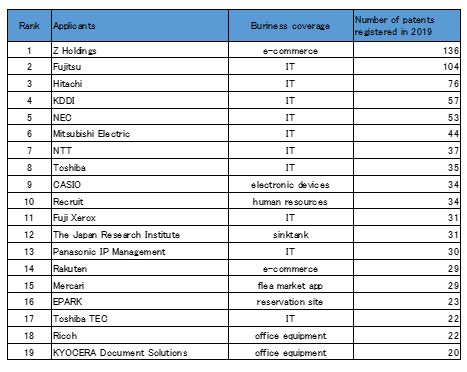
[Reference]
Recent Trends in Business-related Inventions
Updated in July 2020, Patent Examination department (Electronic Technology),
Japan Patent Office
https://www.jpo.go.jp/e/system/patent/gaiyo/recent_trends_biz_inv.html
The JPO Examination Handbook
Annex B Chapter 1 Computer Software-Related Inventions 2.1.1.
The content of this article is intended to provide a general guide to the subject matter. Specialist advice should be sought about your specific circumstances.
